
Kimzha village panorama with Kimzha River. View southeast toward Church of the Hodegetria Icon of the Virgin. August 2, 2000
William BrumfieldIn the summer of 1909, Russian photographer and chemist Sergei Prokudin-Gorsky conducted an extensive journey along the Mariinsky Waterway System, which links St. Petersburg with the Volga River basin. The first major component of the system was the Mariinsky Canal, which connected the Vytegra River (flowing into Lake Onega toward St. Petersburg) and the Kovzha River (flowing south into White Lake). He photographed a number of sites along the way, creating an important historical record of many architectural monuments, some of which have been lost to time.
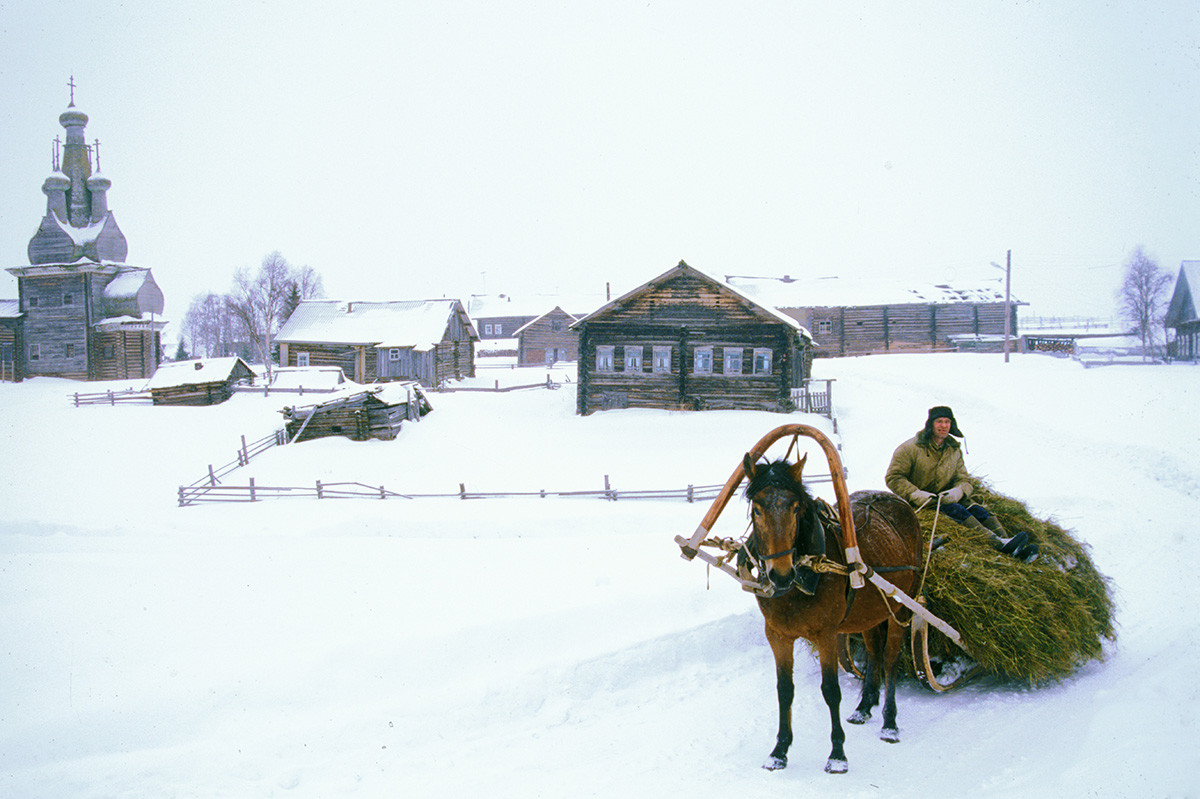
Kimzha village. Church of the Hodegetria Icon, log houses & stables (background). March 7, 2000
William BrumfieldOne of the most picturesque sites photographed by Prokudin-Gorsky that summer was the village of Devyatiny (Vologda Province), situated on the Vytegra River near its link with the Kovzha. Of special interest is his photograph of the wooden Church of the Dormition of the Virgin, built in 1770 to replace an earlier log church destroyed by fire. Unfortunately, the church that he so beautifully photographed also fell prey to fire, but his photographs provide valuable information on traditional northern wooden architecture.
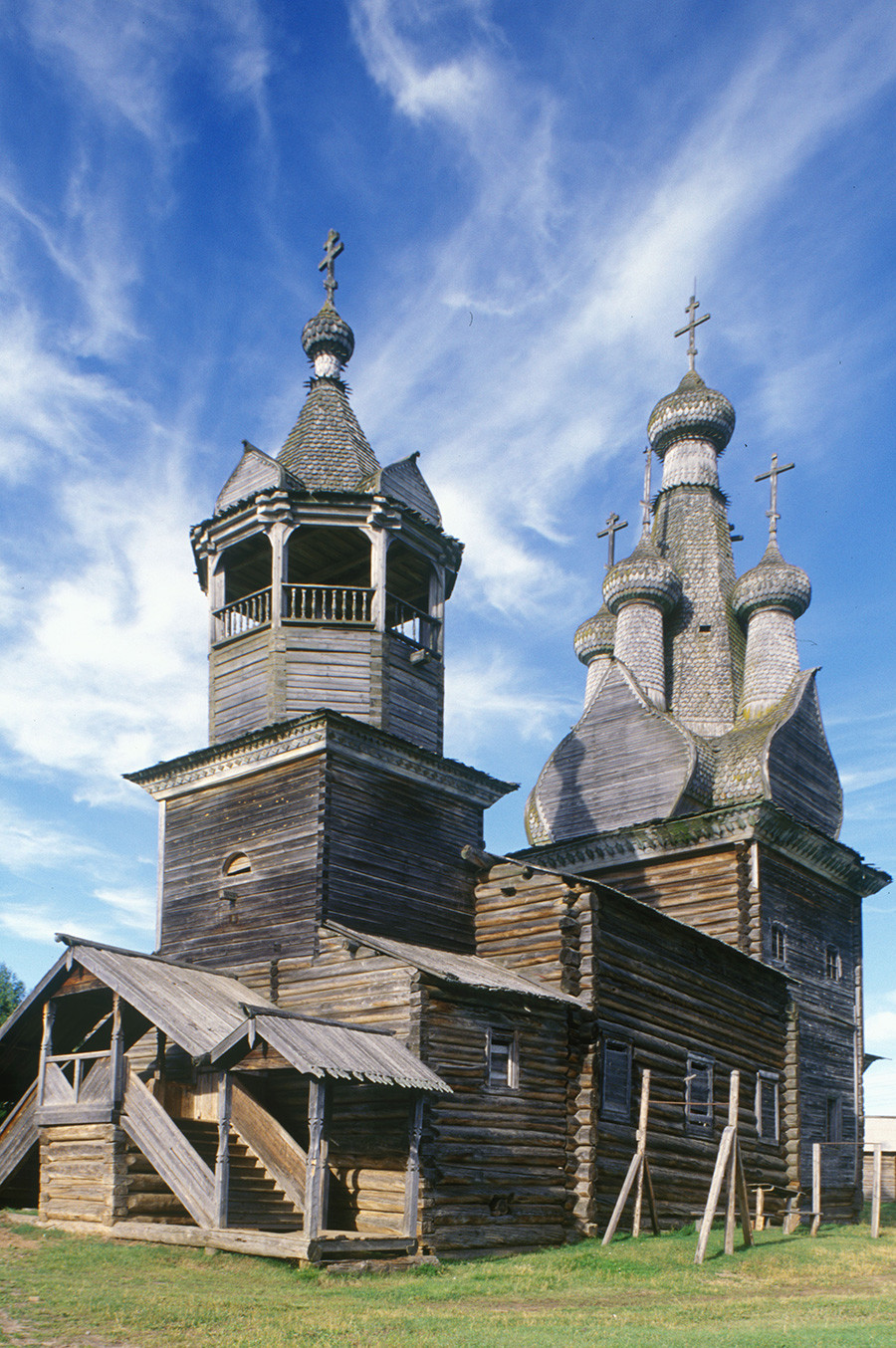
Church of the Hodegetria Icon, southwest view. August 2, 2000
William BrumfieldModest in its proportions, the Dormition Church at Devyatiny followed a typical parish church plan with a one-story vestibule — or refectory — in the west. As stipulated in Russian Orthodox architectural design, the primary altar was placed on the east side.)
The main structure of the Devyatiny church rises from a square base toward four gables that extend in a cruciform pattern from an octagonal upper core. Each of the gables is crowned with a small cupola, while the octagon supports the large central cupola. In a typical 19th-century practice, the log structure was clad with white plank siding, and the cupolas were covered in metal sheathing.
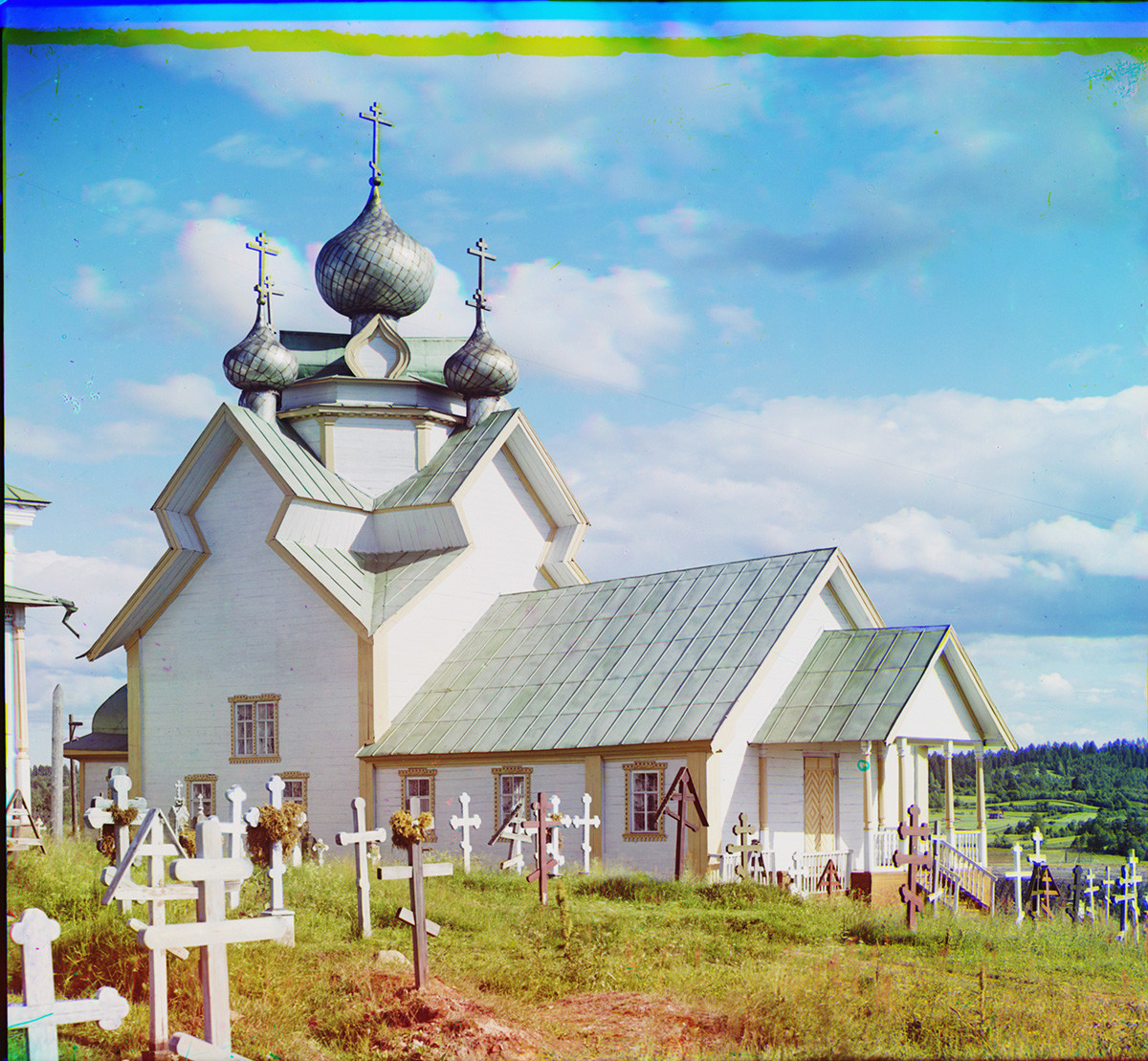
Devyatiny village. Church of the Dormition of the Virgin, northwest view. Destroyed by fire in 1984. Summer 1909
Sergei Prokudin-GorskyLittle remains of the lyrical views that Prokudin-Gorsky photographed at Devyatiny. The Dormition Church, closed in the 1930s, burned to the ground in 1984. An attempt in the 1990s to rebuild the church in a different form near the town cemetery was abandoned for lack of support.

Church of the Hodegetria Icon, southwest view in late evening light. July 31, 2000
William BrumfieldThere are, however, surviving wooden churches in the Russian North that bear a resemblance to the distinctive form of the Devyatiny Dormition Church. One of them is an 18th-century church dedicated to the Hodegetria Icon of the Virgin Mary at the village of Kimzha, in the far northeastern part of Arkhangelsk province.
Situated close to the Arctic Circle near the point where the small Kimzha River flows into the Mezen River, Kimzha was founded at the beginning of the 16th century by settlers from the Pinega River area to the south. It remains one of the best-preserved, most significant traditional settlements in the historic Russian North surrounding the White Sea.
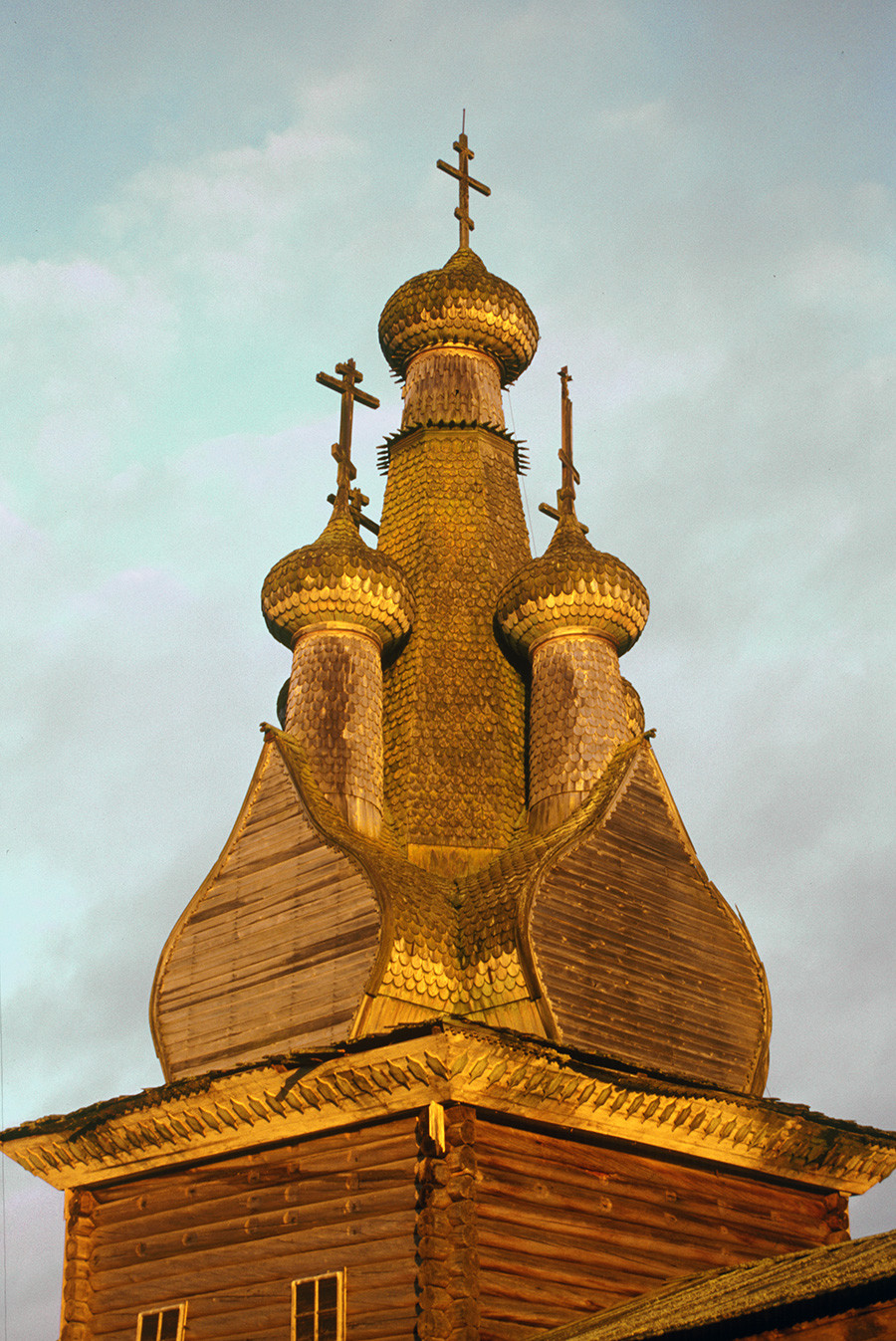
Church of the Hodegetria Icon, upper structure with gables, cupolas & tower. Northwest view in late evening light. July 31, 2000
William BrumfieldFor much of the year, Kimzha lies in the grip of severe winter conditions, stiff wind and snow drifts produced by abundant moisture from the sea. Formerly, there was limited passenger transportation to the Mezen area from the major White Sea port of Arkhangelsk, but that route ceased decades ago.
A year-round transportation option is by small plane from Arkhangelsk’s Vaskovo airport to Mezen, and from there by car (and boat) to Kimzha. During the winter there was a iced forest track, or zimnik, that wound northward from Pinega to Kimzha and Mezen. Yet that was a nerve-wracking, exhausting route (as I can attest), whose usefulness was curtailed by increasingly early spring thaws. Several years ago, a year-round gravel road (No. A11-004) was completed all the way to Mezen, with Kimzha as the road’s main attraction.
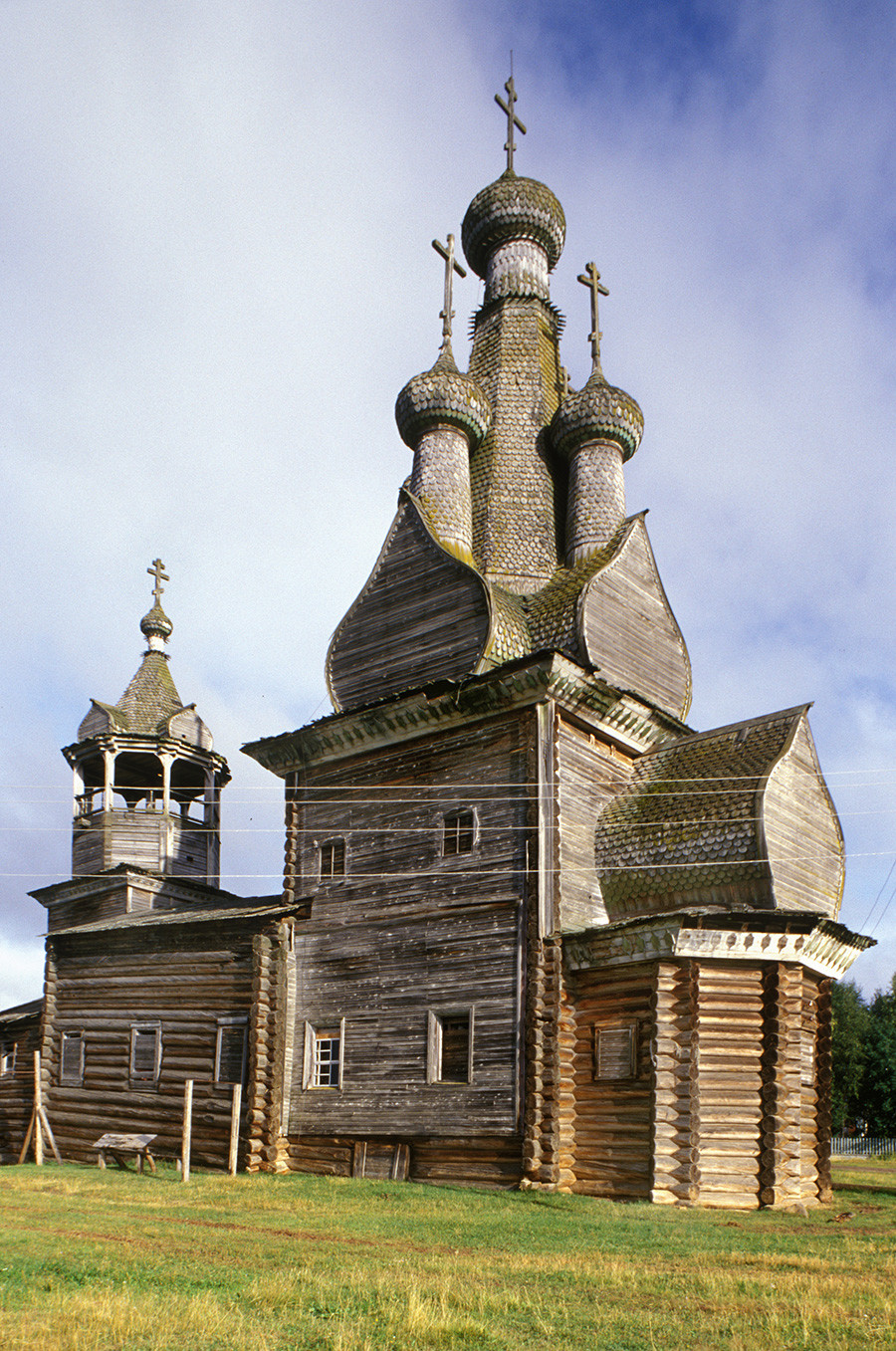
Church of the Hodegetria Icon, southeast view. August 1, 2000
William BrumfieldFrom every perspective, Kimzha is defined by the soaring vertical form of the Church of the Hodegetria Icon — over 27 meters high. A century ago, the Russian north was rich with examples of towering wooden churches such as the Dormition at Varzuga.
The Kimzha church, however, is the sole surviving example of a type with a high central tower and cupola flanked by four small cupolas on gables that buttress the tower. It is known that similar examples were created by carpenters active in the 18th-century in the territory around the Pinega River.
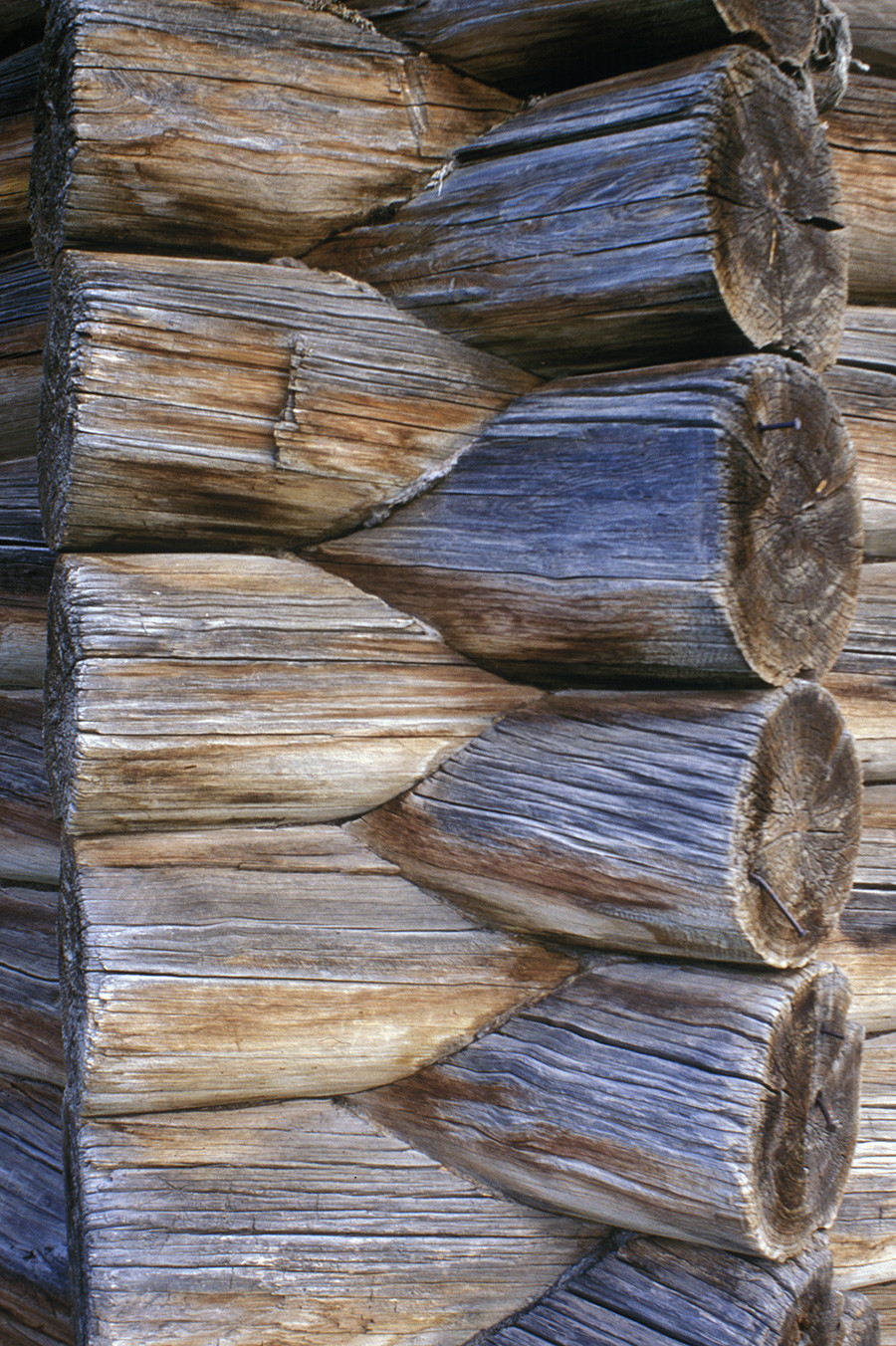
Church of the Hodegetria Icon. Notched larch logs at southeast corner of apse. August 1, 2000
William BrumfieldAlthough the Kimzha church has a much taller tower silhouette than the Devyatiny church, both have a similar arrangement of four cupolas on peaked gables surrounding an elevated central cupola. The more daring form of the Kimzha church was enabled by a combination of superb carpentry and the use of larch logs, an exceptionally durable type of timber.

Church of the Hodegetria Icon, interior. View east toward apse with altar space. August 1, 2000
William BrumfieldIn retrospect it seems remarkable that the Hodegetria Church was ever completed. Begun in 1700 to replace an early 17th-century church that had burned in 1699 from a lightning strike, the church was almost 10 years in construction due to the limited resources of its small parish. After completion of the basic structure, another half-century passed before its recorded consecration in 1763. (I was told that the delay was due to the local prevalence of Orthodox dissenters known as Old Believers, who had their own prayer houses.)
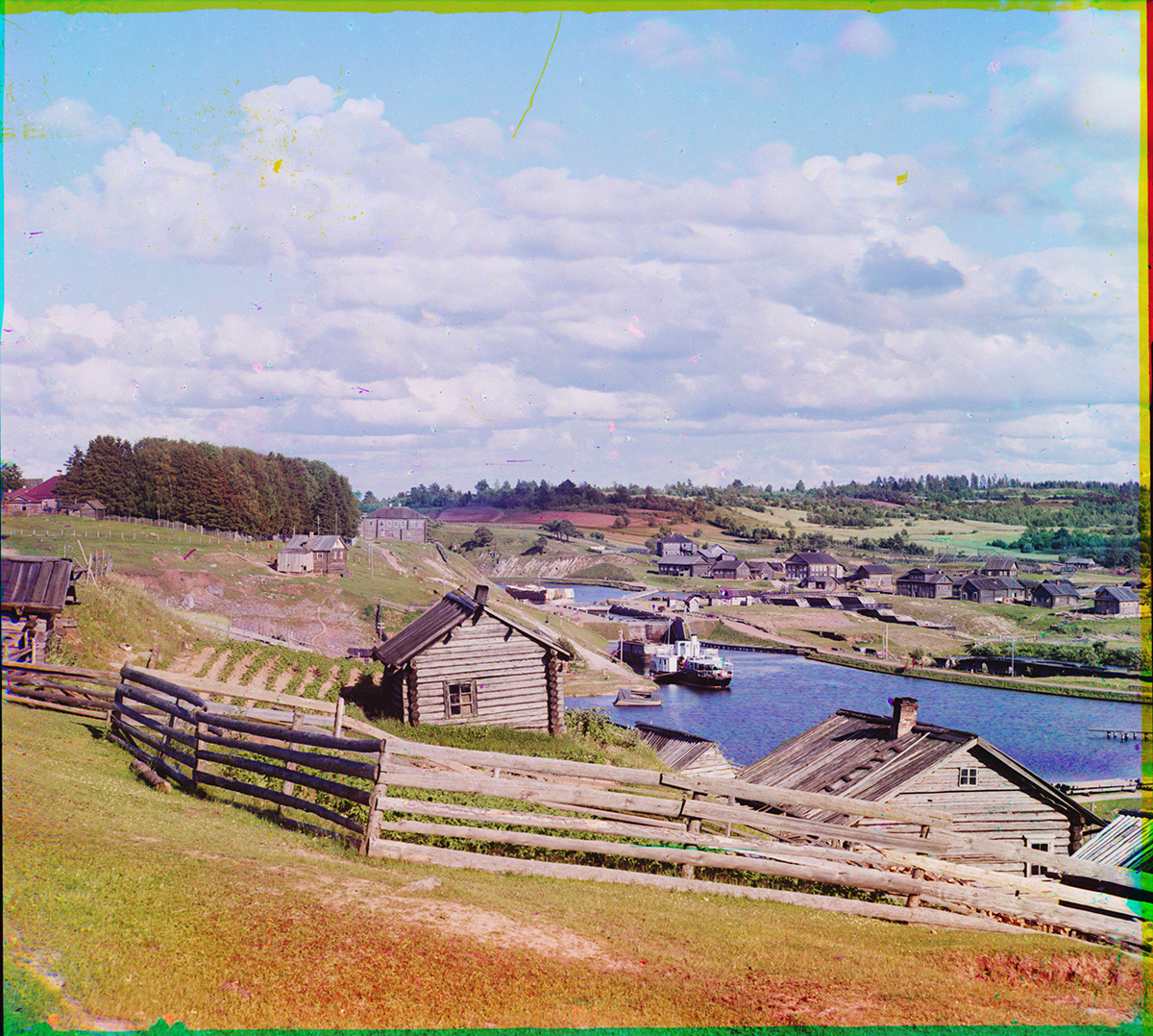
Devyatiny. Ministry of Transportation garden & sheds (not preserved). View toward Vytegra River & St. Paul Lock. (This part of the canal was rerouted and renamed during the Soviet period.) Summer 1909
Sergei Prokudin-GorskyMiraculously, the Hodegetria Church has survived decades of alteration, neglect, and the constant threat of accidental fire. In the 1870s, its tower and cupolas were sheathed in wooden “fishscale” shingles, while the interior was surfaced with planks painted light blue. At the same time (1877-78), a bell tower was erected over the west porch. (An earlier bell frame stood apart from the church on the bank of the Kimzha River.) In the late 1890s the stout log exterior was covered with plank siding painted white with blue and green trim.
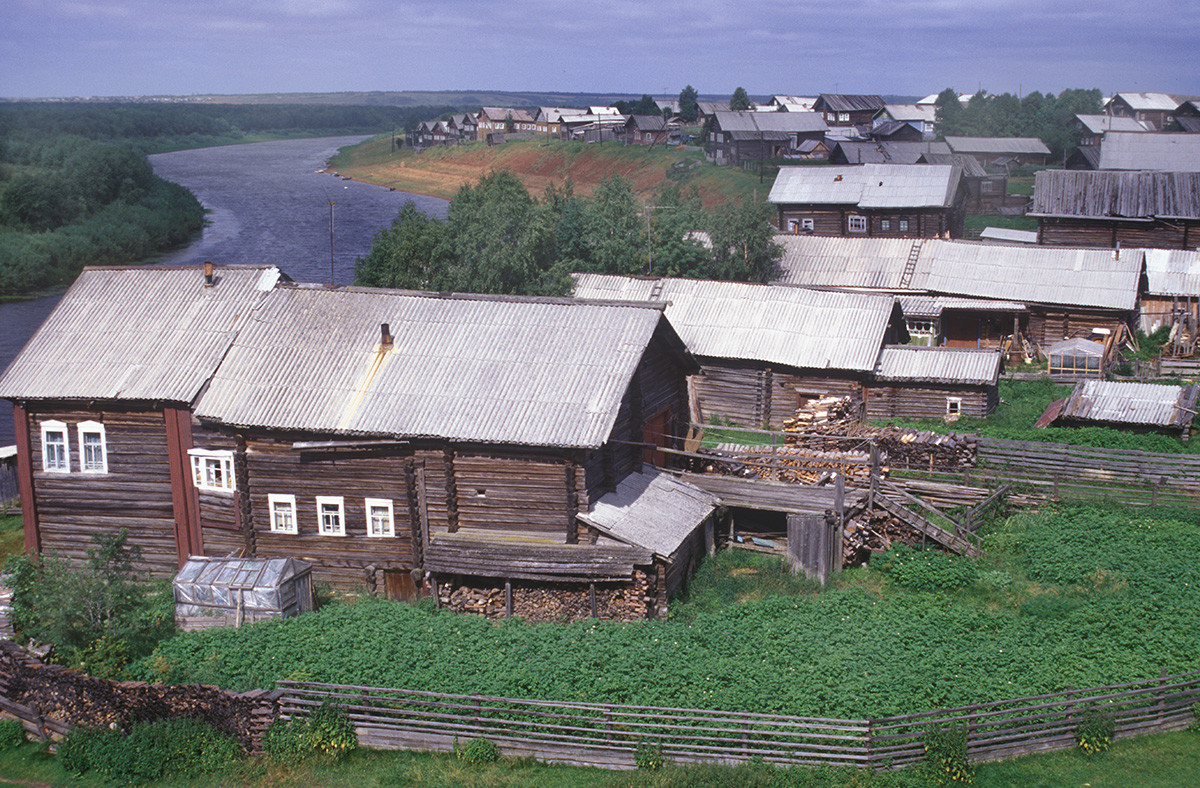
Kimzha village. View north from bell tower of Hodegetria Church. Left: house of Elena Safonova. Background: Kimzha River. August 1, 2000
William BrumfieldAlthough Prokudin-Gorsky did not visit this part of the Russian North, there is a photograph of the Kimzha church published in a 1906 volume by Nikolay Shabunin (1866-1907), a native of the Mezen region. His premature death cut short the career of a talented artist and pioneering specialist in this area of the Russian North. The photograph that he published shows the church in much the same form that I photographed in 2000.
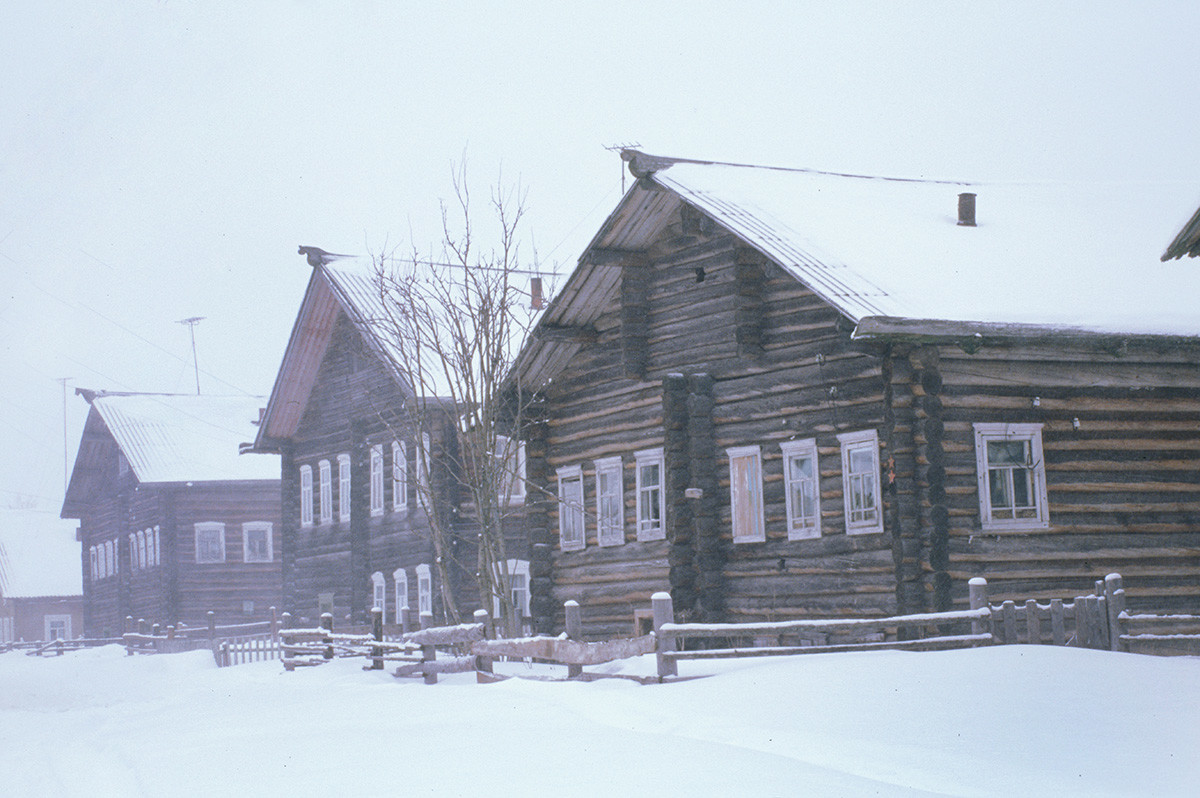
Kimzha. Log houses in snowstorm. March 7, 2000
William BrumfieldSoviet restoration practice frowned on 19th-century white board cladding, and in the 1980s some of the planks were removed from the walls of the Kimzha church. Lack of funds halted this early restoration attempt, and in 2000 the church stood as an unintended display of restoration practice, half with siding and half without.
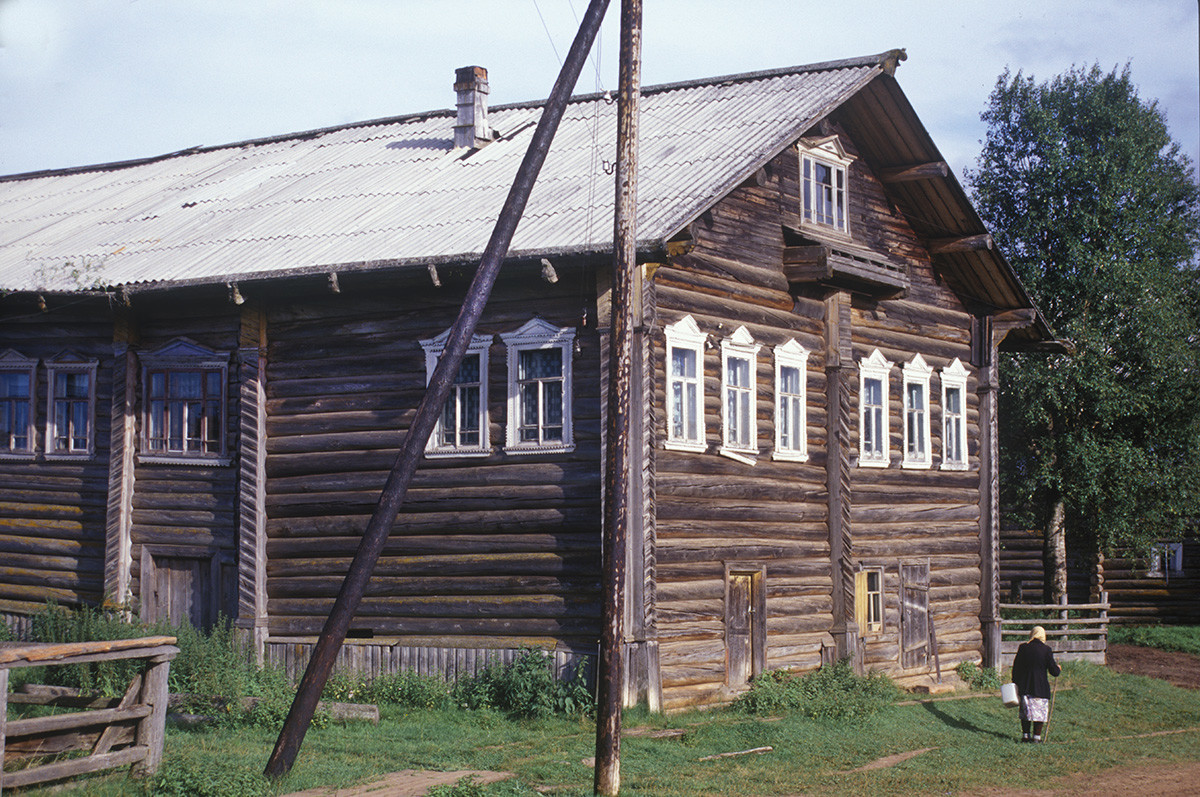
Kimzha. Deryagin house. August 2, 2000
William BrumfieldA local committee succeeded in 1999 in having the padlock removed from the church, which had been closed for worship since the 1930s. Although the reconsecrated church was open for infrequent services led by a priest from Mezen, the building showed ominous signs of deformation.
In 2008 the entire structure was disassembled for restoration, but work was halted for prolonged periods because of contractual issues. The reconstruction was finally completed a decade later covered with new plank siding. As with other examples of wooden architecture in the Russian North, I consider myself fortunate to have photographed the Kimzha church when the original log structure still existed.
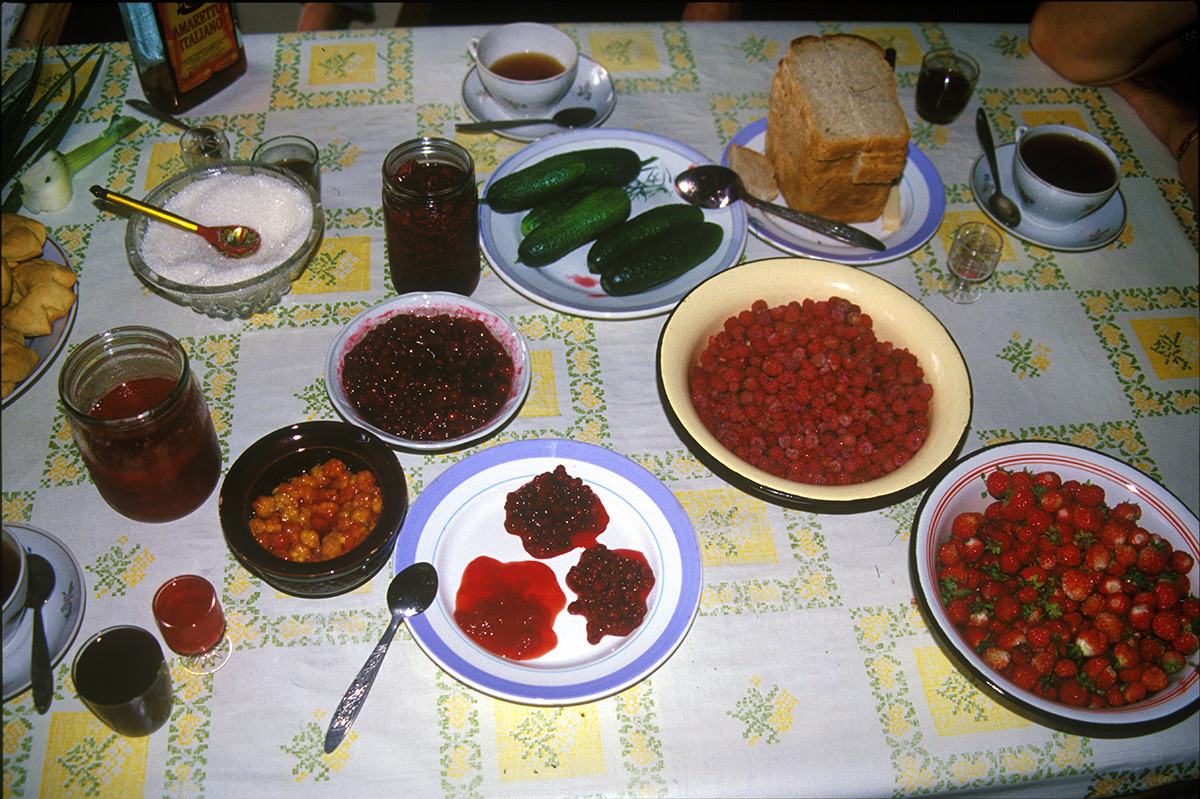
Kimzha. Kitchen table at Lidia Ivanovna's house. Forest berries, garden produce, jams, preserves, kisel, mors--all gathered & produced by Lidia Ivanovna & friends. August 2, 2000
William BrumfieldThe village of Kimzha has a certain magic perhaps best represented by the aquamarine shimmer of the aurora borealis that I saw on my first arrival in the winter of 2000. Together with the Hodegetria Church, the village makes an unforgettable impression with its massive log houses built in the late 19th and early 20th centuries. Although some houses have been shuttered and others modified, Kimzha is a living environment preserved from another era.
Kimzha has survived when dozens of other villages throughout the north have vanished. There are several factors to explain this endurance, but the presence of the Hodegetria Church has undoubtedly played a major role in the village's cohesion. Overcoming many obstacles, Kimzha has found a delicate balance between past and present.
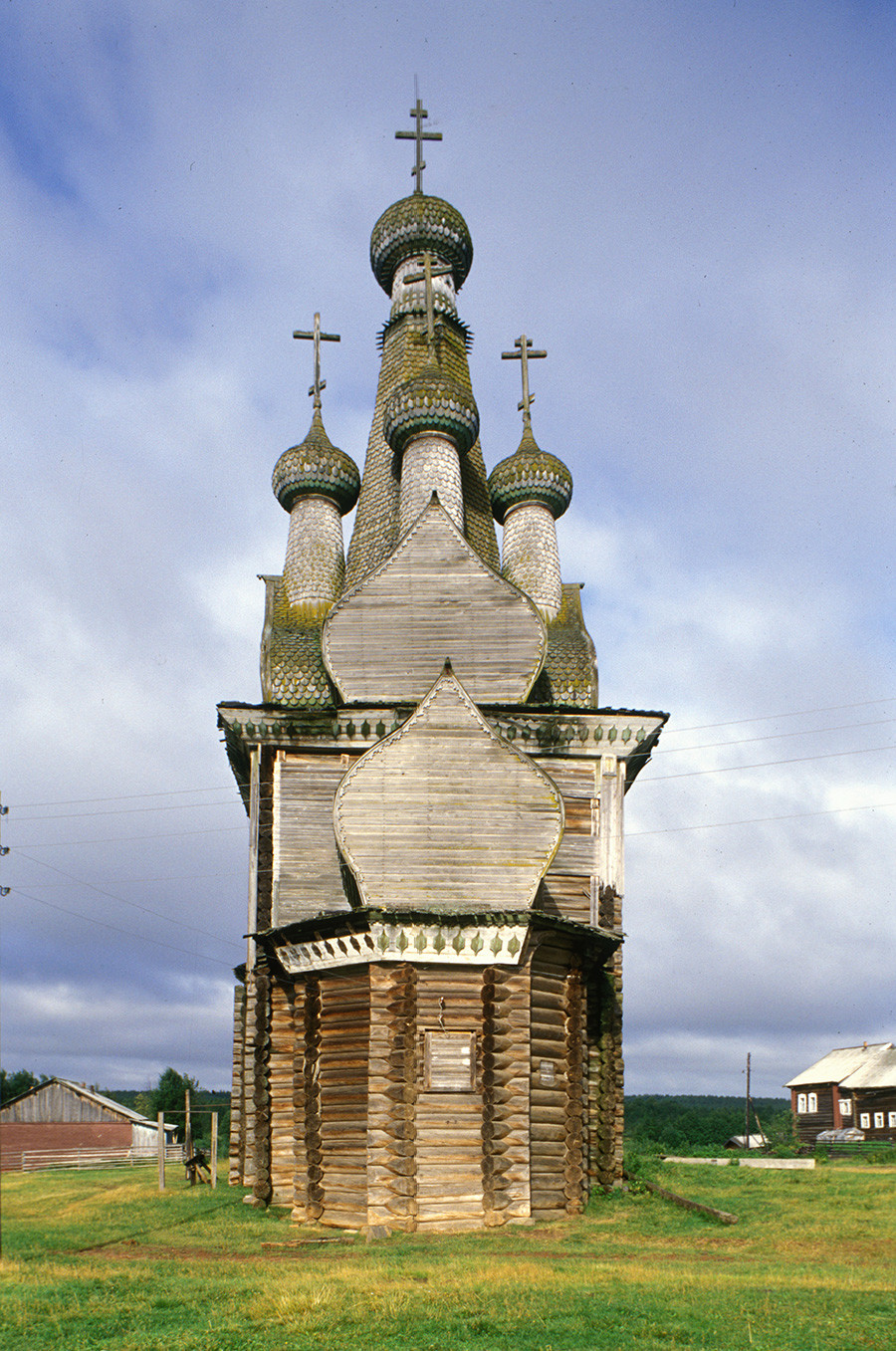
Church of the Hodegetria Icon. East view with apse (larch log structure). August 1, 2000
William BrumfieldIn the early 20th century, the Russian photographer Sergei Prokudin-Gorsky developed a complex process for color photography. Between 1903 and 1916 he traveled through the Russian Empire and took over 2,000 photographs with the process, which involved three exposures on a glass plate. In August 1918, he left Russia and ultimately resettled in France where he was reunited with a large part of his collection of glass negatives, as well as 13 albums of contact prints. After his death in Paris in 1944, his heirs sold the collection to the Library of Congress. In the early 21st century the Library digitized the Prokudin-Gorsky Collection and made it freely available to the global public. A few Russian websites now have versions of the collection. In 1986 the architectural historian and photographer William Brumfield organized the first exhibit of Prokudin-Gorsky photographs at the Library of Congress. Over a period of work in Russia beginning in 1970, Brumfield has photographed most of the sites visited by Prokudin-Gorsky. This series of articles juxtaposes Prokudin-Gorsky’s views of architectural monuments with photographs taken by Brumfield decades later.
If using any of Russia Beyond's content, partly or in full, always provide an active hyperlink to the original material.
Subscribe
to our newsletter!
Get the week's best stories straight to your inbox